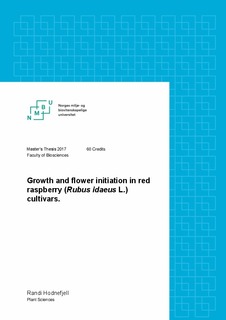| dc.description.abstract | Growth cessation and flower initiation has been studied in different raspberry (Rubus idaeus L.) cultivars to better understand the factors influencing the adaptation of raspberry to a changing Nordic and European climate. Two experiments were conducted: 1. An experiment with constant temperatures (9, 15, 18 and 21C, and ambient temperature) and natural photoperiod in controlled environment in the Ås-phytotrone with the cultivars ‘Glen Ample’, ‘Tulameen’, ‘Veten’, ‘Vene’, ‘Balder’, ‘Anitra’, ‘Schöneman’, ‘Vajolet’ and ‘Lagorai Plus’; 2. A field experiment with the cultivars ‘Glen Ample’, ‘Anitra’, ‘Veten’, ‘Cascade Delight’, ‘Ninni’, ‘Malling Juno’ and the selection RU044003090 (RU90). Growth was monitored in both experiments by weekly measurements of shoot length and leaf number, and flower initiation by weekly sampling and examination of lateral bud number 5-7 from the apex of each plant. The cultivars ‘Glen Ample’, ‘Veten’, ‘Vene’, ‘Balder’, ‘Anitra’ and ‘Ninni’, which are selected for a Nordic climate, ceased growth and initiated floral primordia earlier than cultivars adapted to more southern climate. These cultivars responded earlier because they were more responsive to photoperiod at temperatures >15C and insensitive to photoperiod at temperatures <12C and below. By responding earlier, the plants have more time to differentiate flowers and induce strong winter hardiness. ‘Malling Juno’ and ‘Cascade Delight’ had a similar response as the Nordic cultivars, and can be suitable cultivars for Nordic production. In both experiments two cultivars tip-flowered; ‘Anitra’ in the field experiment and at constant 18C in controlled environment, and ‘Vene’ at constant 18C and 21C in controlled environment. If the Nordic and European climate becomes warmer in the future as predicted, more tip-flowering could be expected. | nb_NO |

